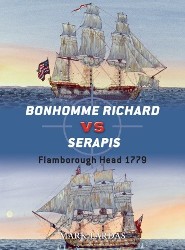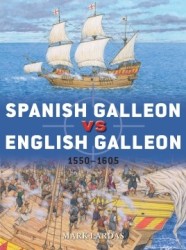 Pirates and Privateers Pirates and Privateers
The History of Maritime
Piracy
Cindy Vallar, Editor
& Reviewer
P.O. Box 425,
Keller, TX 76244-0425
    
Books for Adults ~ Ships &
Sailing
Bonhomme Richard vs Serapis
Spanish
Galleon vs. English Galleon

Bonhomme Richard vs. Serapis:
Flamborough Head 1779
by Mark Lardas
Osprey, 2012, ISBN 978-1-84908-785-8, US $18.95 / UK
£12.99 / CAN $19.95
    
The 1779
battle between Bonhomme Richard and HMS Serapis
at Flamborough Head during the American
Revolution becomes a symbol for the Americans –
resolute, determined, and willing to press forward
regardless of the odds – and the British –
indefatigable and devoted to duty. Within these
pages, Lardas examines the ships, their captains,
and the battle. Even though Richard Pearson
eventually surrenders, he does so only after he
accomplishes his mission, protecting a convoy of
merchant ships, and a second enemy warship comes to
John Paul Jones’s aid.
There are seven chapters in this slim volume.
“Design and Development” discusses naval
architecture of the 1700s, with pertinent
information about Indiamen in general and Bonhomme
Richard in particular, and two-deck warships
in general and HMS Serapis in particular.
“The Strategic Situation” summarizes the war and
events that impact this fateful meeting. “Technical
Specifications” examines the structure, armament,
and sails and rigging, while “The Combatants”
focuses on the men, the officers, and the marines.
The beginning of each ship’s cruise, the opening
stages of battle, and the battle itself are covered
in “Combat.” “Statistics and Analysis” looks at who
has what advantages and the difference between
what’s on paper and the raw numbers. The final
chapter, “Aftermath and Conclusion,” covers what
happens after the surrender, how it affects other
countries’ decisions in entering the war, and what
happens to the captains and ships following their
battle off the Yorkshire coast.
The book is filled with illustrations in color and
in black-&-white; each includes a caption to
clearly identify what is shown. Highlighted diagrams
and inserts provide additional information on the
vessels, copper bottoms, great guns, hand weapons,
press gangs, biographies on the captains,
quarterdeck views from both ships, and Paul Jones
the Pyrate. Color maps delineate the vessels’
movements. Also included are a bibliography, an
index, and a chronology of the captains and the
ships, which encapsulates on two pages the high
points within the book. It begins in 1731, with
Pearson’s birth and concludes in 1806, when he dies.
This is a thorough, yet concise and very readable
account of this battle. Lardas provides a plethora
of information without getting bogged down in
complicated, nautical details and language. It’s an
excellent introduction for anyone who wants to know
about this event, and provides readers with
sufficient background knowledge to allow them to
read and understand more in-depth accounts.


Spanish Galleon vs English
Galleon 1550-1605
by Mark Lardas
Osprey, 2020, ISBN 978-1-4728-3990-9, US $22.00
Also available in other formats
    
Galleon.
The word conjures a specific image in our minds,
even though it represents the epitome of a fighting
ship from a bygone era. This beautifully illustrated
book explores the design and development of
galleons, their technical specifications, and the
differences between their armament and the men who
man them. Lardas also examines and analyzes three
specific engagements – Golden Hind’s
encounter with Nuestro Señora de la Concepción,
San Mateo during the Battle of Gravelines,
and Revenge against five of Spain’s Twelve
Apostles – to show how these warships are used and
their effectiveness as fighting machines. To fully
grasp their significance in world affairs, it is
first essential to understand the relationship
between Spain and England in the 16th century.
Spain stands at the zenith of her power. England, on
the other hand, is just beginning her long trek to
dominate the maritime world and become a superpower.
Spain’s reach extends far beyond its European
borders, and the riches of its colonial empire
entice other countries to seek their own wealth and
property in distant lands. The need to protect and
the yearning for great treasure requires shipwrights
to devise vessels that can travel far distances,
carry large cargoes, and defend themselves against
raiders.
These must-haves lead to the galleon, a new class of
warship that can cross oceans and deliver broadsides
to any who dare attack them. What distinguishes a
galleon from her predecessors is that she has
multiple decks, including a lower gun deck, and
three or four masts capable of carrying square and
lateen sails. She has high fore- and sterncastles,
but she is not always a large ship. Each is financed
by a syndicate, rather than a navy, and she is built
to carry cargo even though she is well-armed and has
the power to seriously damage an opponent’s hull.
Spain’s galleon and England’s race-built galleon are
sturdy vessels that can survive tumultuous seas and
weather, but hazards and shipboard life remain
dangerous to a man’s health. Magellan leaves Spain
in 1519 with 270 men; when his ship returns home,
only eighteen remain alive, but Magellan is not one
of them. Drake’s 1577 expedition consists of 150
men, of which only about one third survive.
This comparison between Spanish and English galleons
concludes with a brief summary of why they fade from
use and how we pay homage to them today with
replicas. In addition, Lardas provides a
bibliography, index, and chronology of historical
events from Christopher Columbus’s landfall in the
Bahamas in 1492, until Pedro Sarmiento de Gamboa’s
death in 1608. Contemporary artwork, color
photographs, paintings, maps, and diagrams are found
on nearly every page, while special highlights are
scattered throughout to provide further
investigation into specific subjects, such as
cannon, how a galleon maneuvers, navigation, and two
ships – Nuestra Señora de la Concepción
and Golden Hind – and two captains, Sir
Francis Drake and Sarmiento de Gamboa.
Most books about galleons focus on Spanish vessels,
but Lardas provides a clear, concise, and
well-encapsulated overview of the differences and
similarities between both nations’ ships. The
narrative is enlightening, easy to read, and
engaging. The highlighted engagements between the
ships are an added bonus that provide readers with a
good understanding of the differences in fighting
techniques and the dynamics of their evolution. This
is an excellent introduction to galleons, as well as
a first-class addition to any maritime collection.

Click to contact me
Background image compliments
of Anke's Graphics |


